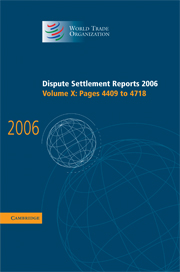European Communities – Selected Customs Matters (WT/DS315): Table of Annexes
Published online by Cambridge University Press: 12 December 2017
Summary
QUESTIONS FOR THE UNITED STATES:
Please respond to the assertion by the European Communities in paragraph 14 of its First Written Submission that the measure at issue in this dispute is “the manner in which the EC administers” customs laws.
In this dispute, the United States is challenging the manner in which EC customs law is administered (as well as the absence of EC tribunals or procedures for the prompt review and correction of customs administrative decisions, as required by Article X:3(b) of the GATT 1994). In particular, we are challenging the absence of uniformity in the administration of EC customs law. The manner in which the EC administers its customs law – that is, the lack of uniformity in such administration – may not itself be a “measure.” The “specific measures at issue” for purposes of Article 6.2 of the Understanding on Rules and Procedures Governing the Settlement of Disputes (“DSU”) are the laws, regulations, decisions and rulings that make up EC customs law, though in some cases these are being administered through laws and regulations which are themselves measures. These measures are identified in the first paragraph of the US request for the establishment of a panel (and are set out again in Question No. 3 of the Panel's consolidated questions). The United States does not challenge the substance of these measures but, rather, the lack of uniformity in their administration.
Lack of uniformity in administration of the measures at issue manifests itself in a number of different ways. One way in which it manifests itself is through the existence of different instruments in different member States to enforce EC customs law. For example, to the extent that different EC member States have available and apply different penalties to enforce EC customs law, this is evidence of a lack of uniformity in the administration of EC customs law. Similarly, to the extent that different EC member States have available and apply different audit procedures to ensure compliance with EC customs law, this too is evidence of lack of uniformity in the administration of EC customs law.
- Type
- Chapter
- Information
- Dispute Settlement Reports 2006 , pp. 4411 - 4718Publisher: Cambridge University PressPrint publication year: 2008
- 1
- Cited by



